
Another year, another calendar. Check it out at Cafepress: thirteen of our photos from around Kitakami, Iwate, and other nearby places in Tohoku! Just click the calendar to take a closer look.
 Another year, another calendar. Check it out at Cafepress: thirteen of our photos from around Kitakami, Iwate, and other nearby places in Tohoku! Just click the calendar to take a closer look. Late at night, especially on weekends, there's a common sight on the streets of Kitakami: pairs of cars, one with a taxi-style light on the roof. But if you look closely, the printing on the taxi light doesn't say "taxi". It says "daikou".
Daikou is a service for people who drive to a bar, pub, party, karaoke, or whatever, then drink. Drinking and driving laws here are draconian, so even if you've only had one drink all evening, you can't drive home. Instead, you call a daikou company. They arrive with a car (the one with the light on it) and two drivers. One of them drives you home (or to the next party) in your car, and the other car follows to take the driver to the next fare. Amazingly, this service is cheaper than taking a taxi, so it's very popular. The genkan, or entryway, serves an important purpose in Japanese buildings. It is much more of a transition zone between inside and outside than in most American homes. When we enter someone's home or an office building, we remove our shoes and coats in the genkan before we enter; similarly, when we leave we put our outerwear back on in the genkan. Except that putting my coat on in the entryway is the one custom I just can't get after a year and a half.
We've put a lot of effort into learning many of the niceties of daily Japanese life and do a reasonable job of being polite members of society. So it's especially frustrating that something as basic as not wearing my coat all the way inside won't stick with me. Actually, it's more embarrassing than that: it wasn't until last week that it really sank in that wearing my coat inside was not daijoubu. And I had that unfortunate revelation as I was leaving a classroom at one of the companies where we teach, coat on. After that, it was like the Japanese etiquette mistake version of the walk of shame — walking quickly, kind of slinking, looking at absolutely no one as I went. Mortification still fresh in my mind, I returned to the company today for my regular class, firmly reminding myself that I would not put my coat on until I reached the genkan. Which I successfully managed to do, but only after wearing my coat most of the way to the classroom when I got there. Maybe I need to tie my coat to my shoes with string. Just a quick note to let our readers know we won't be updating much for the next week or so; we should be back in full swing by mid-December, though!
That Japanese people love karaoke is a stereotype, but it's a well-grounded one. Allowing that there are some who dislike karaoke, the vast majority of our friends enjoy it. Any group of people out having a good time is likely to end up in a karaoke bar or "box" (where you can rent a room for a private party with your friends).
It's hard not to get into the spirit when you're with a bunch of people unironically having fun singing shmoopy love ballads, TV show theme songs, and classic American or British rock songs. At first we chose songs from the (rather limited) selection available in English, but as we've been exposed to more and more Japanese music, we've branched out to sing our favorite Japanese songs, too. It takes a lot of practice, but it's great fun. As an added bonus, it's not unusual to find examples of grammar we've recently studied. Of course, we learn new vocabulary, too, and get lots of reinforcement for the vocabulary of drama: tears, rain, new love, broken hearts, and fiery passion. Natural exposure is really important for gaining fluency, so karaoke is great for improving our language skills. That's why we spent the afternoon studying The Blue Hearts, The Cro-magnons, Shonen Knife, Color Bottle, Thelma Aoyama, Kyu Sakamoto, and others. If you ever need to buy soy sauce at the conbini, be sure to read the label first:
I love how emphatic the beverage is about not being soy sauce. Winter has already arrived in Kitakami, which means it's time to start making nabe. Nabe is the Japanese word for cooking pot; the term is also applied to various one-pot dishes like soups, stews, or sukiyaki. One of our favorite nabe comes from Akita Prefecture: kiritanpo nabe.
Kiritanpo is made by mashing cooked rice into a paste, then shaping the paste around a stick and grilling it. Because they get soft rather quickly, they're added to the nabe toward the end of cooking. Chicken thigh, shirataki (noodles made of devil's tongue jelly), maitake mushrooms, carrots, and seri (Japanese parsley) rounded out the nabe. It was the perfect dish for a frigid, rainy night. กก When you get damaged or misdirected mail in America, it usually arrives with some sort of brief explanation. Often, the explanation is an impersonal form with one of multiple preprinted reasons checked off (or the ever-popular "Other," with a terse, often illegible explanation). It might also say "We apologize for any inconvenience," or something like that. It's all very cold and official.
Not so in Japan: This came on a piece of mail we'd been expecting to arrive from America last month. It says, essentially: "This mail was sent from America to Jamaica, then arrived in Japan on November 13. The honorable customer's important mail was delivered late, and for that, we offer our deepest apologies." Interestingly, it seems that mail from America bound for Japan gets sent to Jamaica often enough to warrant preprinted labels with spaces to write in the date. Unlike last year, I haven't been getting sick on a monthly basis. Unfortunately, I have gotten sick enough to require my first visit to a doctor in Japan. As one does, I went to the doctor that came recommended by a student. This doctor had the added benefit of having the most entertaining office sign in Kitakami:
Unless you're presenting with a dire emergency, the medical intake process in Japan is very DIY. The nurse handed me a digital thermometer along with the patient information sheet so that I could take and record my temperature. Once that was done, she pointed me to the self-service automatic blood pressure cuff. Much like the photo booth at the drivers' license center, the machine exhorted me to relax before pressing the button to activate it. Communicating with the doctor was not as hard as I feared it would be, save for a misunderstanding about why needles were going to be involved. After doing a blood test and determining that I did not have pneumonia, the doctor sent me off with a prescription and a directive to fill it at the pharmacy across the street. Which I did, and encountered one of the more curious things about Japanese medicine: powdered medicine. I also got a couple of different kinds of medication in addition to the powder (although not as many as the six pills plus powder Matthew got for his recent illness). They weren't difficult to take and they worked, but given the side effects (anyone who's ever taken corticosteroids would understand), I think I might just skip the doctor in the future. Why have we posted so many sea photos this week? It's because we took a trip to Miyako, on the Pacific coast of Iwate. Matthew had a model railroad event there, so we took the opportunity to explore part of Iwate we hadn't visited and enjoy some fresh seafood.
Miyako is most famous for its spectacular rock formations, especially those at Jodogahama. 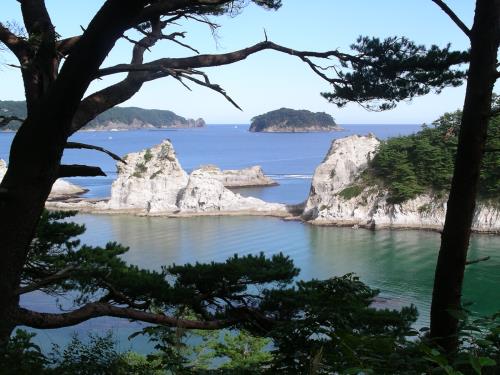 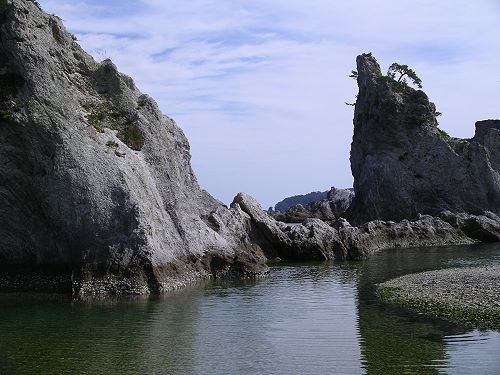 There's a protected rocky beach at Jodogahama, where old women spread out konbu seaweed to dry. 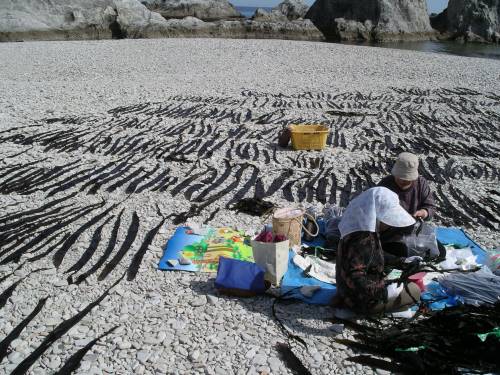 We were there pretty early in the morning, which turned out to be a good thing. We got to see the nearly empty beach, but less than an hour later it was overrun with tourists. 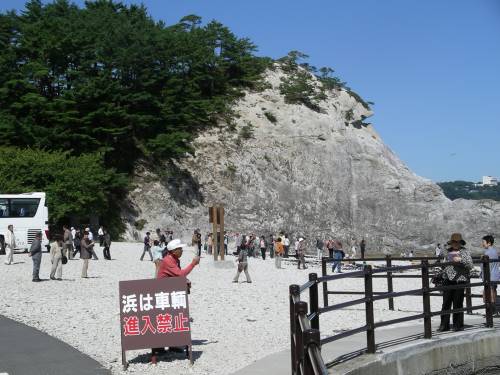 Of course, no visit to the sea is complete without fresh seafood. We stayed at a minshuku (a kind of traditional "bed and dinner and breakfast" lodge) owned by a fisherman. Naturally, the morning's catch was the evening's dinner. 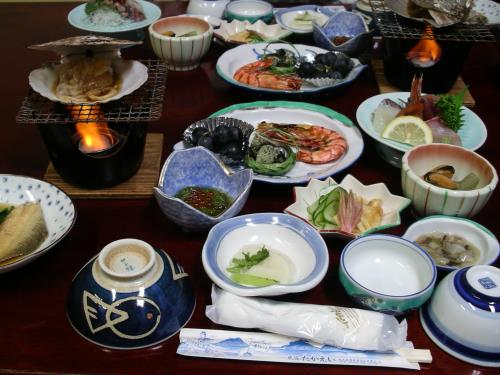 Back Next |